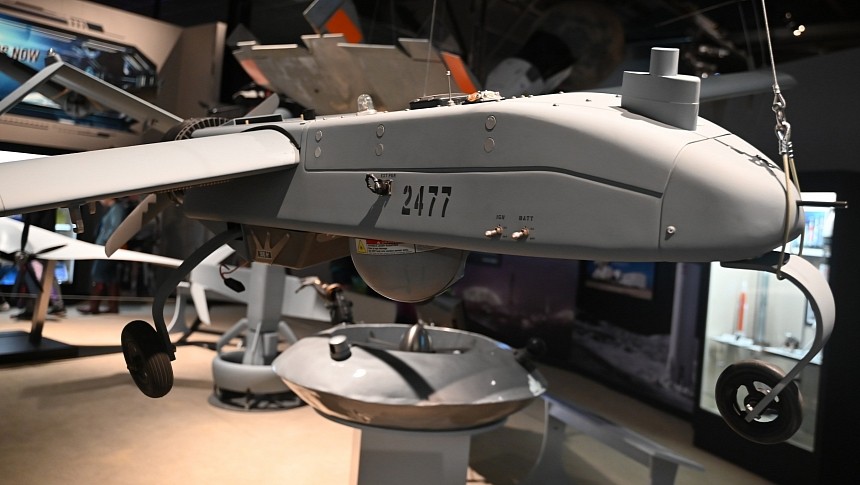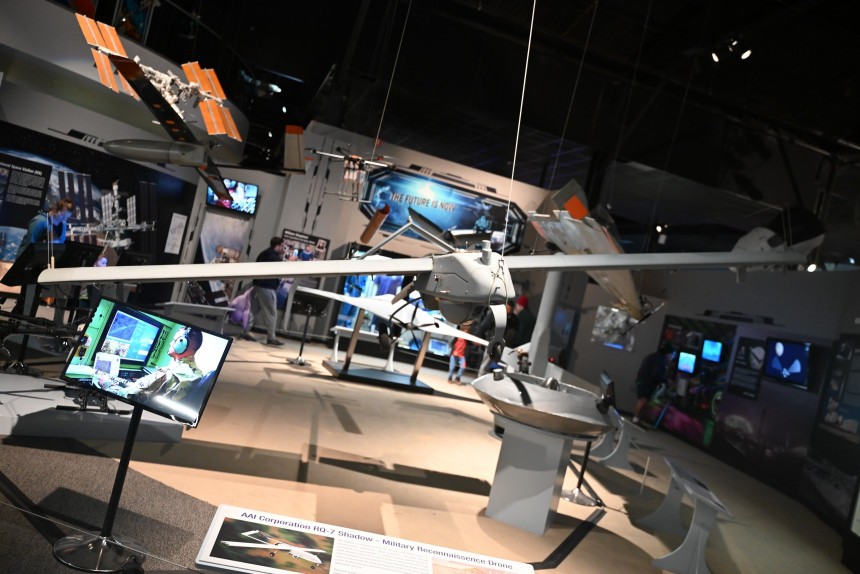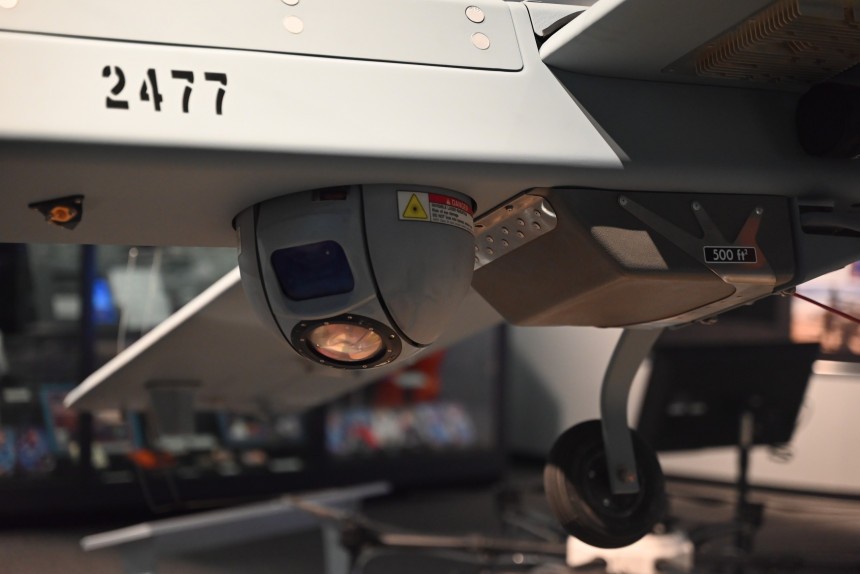The last time we checked out the Cradle of Aviation Museum in Long Island, New York, their seasonal change in exhibit space was dedicated to personal air mobility, with a section of a museum dedicated to lightweight electric machines that could lift one or two people into the sky relatively cheaply. This time around, the same space is dedicated to UAVs, drones, and all things unmanned.
Among the items on display at the museum this time around was a genuine piece of current U.S. Army and Marine Corps kit that we bet even seasoned aviation geeks might not be familiar with. This is an AAI RQ-7 Shadow, and it might be the most interesting military UAV you haven't heard of. As one of the Pentagon's most solid and reliable UAV manufacturers, AAI Corporation might not be a household name. But rest assured, AAI is a valuable asset to the U.S. Military's drone fleet.
Though uncrewed aerial drones are arguably as old and historic as military airplanes themselves, it's safe to call the period between the mid-1970s and the early 1990s the first golden age of remote-controlled UAVs. It was during this period that AAI, founded under the name Aircraft Armaments Inc out of Hunt Valley, Maryland, in 1950, launched a bespoke unmanned systems division in 1985. With the help of the lauded Israeli Aircraft Industries, AAI manufactured its first military UAV, the RQ-2 Pioneer, in 1986.
Essentially a domestic upgrade platform of the Israeli IAI Scout, the RQ-2 Pioneer shared an uncanny appearance with another Israeli UAV, the Tadiran Mastiff, which is widely considered to be one of the very first modern military UAVs. With an emphasis put squarely on long flight ranges, quiet surveillance, and reconnaissance, the 205-kilogram (452 lb) RQ-2's two-stroke boxer engine propelled the craft to a range exceeding 100 miles. As a solid UAV platform, the RQ-2 formed a fitting foundation for the next in line at AAI's Maryland manufacturing facility.
First commissioned in the late 1980s and first flown in 1991, the RQ-7 Shadow was designed to replace the canceled Alliant RQ-6 Outrider as well as the now-defunct RQ-2. With a similar size and silhouette to the outgoing model, it's almost easy to assume the RQ-7 is the same internally as well. But this is the furthest thing from the truth. In fact, the RQ-7 is a profoundly more capable vehicle from a flight performance and from a surveillance perspective.
With dimensions of 11 feet, two inches (3.41 m) long with a 14-foot (3.87-m) wingspan and a fully loaded weight of just 375 lb (170 kg), the RQ-7 packs plenty of hardware into a very compact space. With the capability to be launched from mobile vehicles and ships, from STOL catapults, or even from traditional tarmac runways, the RQ-7 is as adaptable as it is effective at conducting surveillance. The RQ-7's visual prowess has much to do with its gimbal-mounted, liquid nitrogen-cooled optoelectric/infrared camera system, which relays high bit-rate data back to base camp using the C-band data link between 4.0 and 8.0 gigahertz.
Using this system, the RQ-7 can relay real-time updates on the positions of enemy vehicles, combatants, and the movements over time thereof. Here on display at the Cradle of Aviation Museum, this camera and data-link system is perhaps the Shadow's most prominent and recognizable feature. By itself, all this clever tech would make the RQ-7 Shadow a remarkable machine. But it's not the only part of this warbird that intrigues and excites us.
Even the engine in this little wonder plane is of a particularly unique variety. It's a 208 cc AR741 single-rotor Wankel engine courtesy of the British aerospace firm UAV Engines. That's right, the engine inside this military drone is operationally identical to that in the Mazda RX-7 and RX-8. Weighing in at just 23.5 lbs (10.7 kg) thanks to a clever electronic contactless magneto ignition system, the AR741 cranks out 38 horsepower when running on the proper 100LL-grade aviation fuel.
This engine does have the ability to run on your average 87-octane pump fuel. But after field reports from Iraq during the War on Terror reported a high rate of engine failure, the Army highly recommended using Avgas instead whenever possible. With operational experience with the U.S. Army and Marine Corps but also with the militaries of Sweden, Turkey, Italy, Australia, and Romania, the RQ-7 in both its 200 and 600 series, is one of the most important NATO UAV assets in their current arsenal.
To be able to see a real piece of modern military aviation hardware up close and personal at the Cradle of Aviation Museum is a treat not many people in the world can say they've experienced. It's just another reason the Cradle is one of our very favorite air and space museums in America.
Though uncrewed aerial drones are arguably as old and historic as military airplanes themselves, it's safe to call the period between the mid-1970s and the early 1990s the first golden age of remote-controlled UAVs. It was during this period that AAI, founded under the name Aircraft Armaments Inc out of Hunt Valley, Maryland, in 1950, launched a bespoke unmanned systems division in 1985. With the help of the lauded Israeli Aircraft Industries, AAI manufactured its first military UAV, the RQ-2 Pioneer, in 1986.
Essentially a domestic upgrade platform of the Israeli IAI Scout, the RQ-2 Pioneer shared an uncanny appearance with another Israeli UAV, the Tadiran Mastiff, which is widely considered to be one of the very first modern military UAVs. With an emphasis put squarely on long flight ranges, quiet surveillance, and reconnaissance, the 205-kilogram (452 lb) RQ-2's two-stroke boxer engine propelled the craft to a range exceeding 100 miles. As a solid UAV platform, the RQ-2 formed a fitting foundation for the next in line at AAI's Maryland manufacturing facility.
First commissioned in the late 1980s and first flown in 1991, the RQ-7 Shadow was designed to replace the canceled Alliant RQ-6 Outrider as well as the now-defunct RQ-2. With a similar size and silhouette to the outgoing model, it's almost easy to assume the RQ-7 is the same internally as well. But this is the furthest thing from the truth. In fact, the RQ-7 is a profoundly more capable vehicle from a flight performance and from a surveillance perspective.
Using this system, the RQ-7 can relay real-time updates on the positions of enemy vehicles, combatants, and the movements over time thereof. Here on display at the Cradle of Aviation Museum, this camera and data-link system is perhaps the Shadow's most prominent and recognizable feature. By itself, all this clever tech would make the RQ-7 Shadow a remarkable machine. But it's not the only part of this warbird that intrigues and excites us.
Even the engine in this little wonder plane is of a particularly unique variety. It's a 208 cc AR741 single-rotor Wankel engine courtesy of the British aerospace firm UAV Engines. That's right, the engine inside this military drone is operationally identical to that in the Mazda RX-7 and RX-8. Weighing in at just 23.5 lbs (10.7 kg) thanks to a clever electronic contactless magneto ignition system, the AR741 cranks out 38 horsepower when running on the proper 100LL-grade aviation fuel.
This engine does have the ability to run on your average 87-octane pump fuel. But after field reports from Iraq during the War on Terror reported a high rate of engine failure, the Army highly recommended using Avgas instead whenever possible. With operational experience with the U.S. Army and Marine Corps but also with the militaries of Sweden, Turkey, Italy, Australia, and Romania, the RQ-7 in both its 200 and 600 series, is one of the most important NATO UAV assets in their current arsenal.














